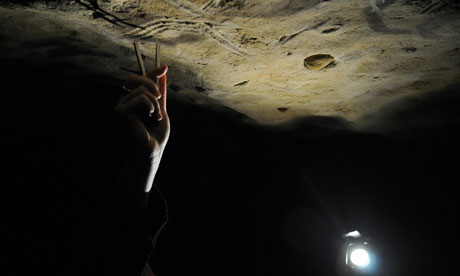Stone age toddlers may have attended a form of prehistoric nursery where they were encouraged to develop their creative skills in cave art, say archaeologists.
Research indicates young children expressed themselves in an ancient form of finger-painting. And, just as in modern homes, their early efforts were given pride of place on the living room wall.
A Cambridge University conference on the archaeology of childhood on Friday reveals a tantalising glimpse into life for children in the palaeolithic age, an estimated 13,000 years ago.
Archaeologists at one of the most famous prehistoric decorated caves in France, the complex of caverns at Rouffignac in the Dordogne known as the Cave of a Hundred Mammoths, have discovered that children were actively helped to express themselves through finger fluting – running fingers over soft red clay to produce decorative crisscrossing lines, zig-zags and swirls.
The stunning drawings, including 158 depictions of mammoths, 28 bisons, 15 horses, 12 goats, 10 woolly rhinoceroses, four human figures and one bear, form just a small proportion of the art found within the five-mile cave system.
The majority of the drawings are flutings covering the walls and roofs of the many galleries and passages in the complex. One chamber is so rich in flutings by children it is believed to be an area set aside for them. The marks of four children, estimated to be aged between two and seven, have been identified there.
"It suggests it was a special place for children. Adults were there, but the vast majority of artwork is by children," said Jess Cooney, a PhD student at the university's archaeology department.
"It's speculation, but I think in this particular chamber children were encouraged to make more art than adults. It could have been a playroom where the children gathered or a room for practice where they were encouraged to make these marks in order that they could grow into artists and make the beautiful paintings and engravings we find throughout the cave, and throughout France and Spain. Or it could have been a room used for a ritual for particular children, perhaps an initiation of sorts."
The presence of children's art was first revealed in 2006 by archaeologists Leslie Van Gelder, of Walden University, in the US, and her husband Kevin Sharpe. Cooney, working alongside Van Gelder, has spent two years analysing the presence of the hunter-gatherer offspring.
Flutings thought to be by a five-year-old girl are the most prolific throughout the cave system. Work by four adults has also been identified, though it is possible there were two further adults present.
The juxtaposition of the flutings of individuals indicate the relationships between the cave dwellers, the researchers say. For example, the markings show that one seven-year-old girl was most often in the company of the smallest of the adults, probably a male and possibly an older brother.
"Some of the children's flutings are high up on walls and on the ceilings, so they must have been held up to make them or have been sitting on someone's shoulders," said Cooney.
Flutings by the two-year-old suggest the child's hand was guided by an adult. Cooney said: "The flutings and fingers are very controlled, which is highly unusual for a child of that age, and suggests it was being taught. The research shows us that children were everywhere, even in the deepest, darkest, caves, furthest from the entrance. They were so involved in the art you really begin to question how heavily they were involved in everyday life.
"To be honest, I think there were probably very few restrictions on what children were allowed to do, and where they were allowed to go, and who they were allowed to go with.
"The art shows us this is not an activity where children were running amok. It shows collaboration between children and adults, and adults encouraging children to make these marks. This was a communal activity."
The significance of finger flutings, also found in other caves in France, Spain, New Guinea and Australia, has been widely debated in archaeological circles. Some regard the marks as doodlings, prehistoric graffiti, while others suggest rituals.
"We don't know why people made them. We can make guesses like they were for initiation rituals, for training of some kind, or simply something to do on a rainy day," said Cooney.
"In addition to the simple, meandering lines, there are flutings of animals and shapes that appear to be crude outlines of faces, almost cartoon-like in appearance. There are hut shapes called tectiforms, markings thought to have a symbolic meaning which are only found in a very specific area of France.
Cooney said the object of her research was "to allow prehistoric children to have a voice", because so much archaeological study focused on men's activities.
"What I found in Rouffignac is that the children are screaming from the walls to be heard. Their presence is everywhere. And there is a five-year-old girl constantly shouting: 'I wanna paint, I wanna paint'."
For more interesting topics related to archaeology, visit archaeology excavations.
Archaeology excavation is best known and most commonly used within the science of archaeology. In this sense it is the exposure, processing and recording of archaeological remains.
Thursday, September 29, 2011
Art Of The Stone Age Has Been Teaching Children, Study Says
Subscribe to:
Post Comments (Atom)

No comments:
Post a Comment